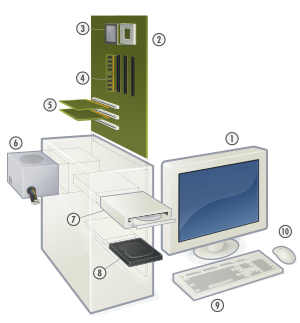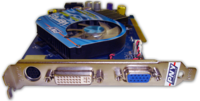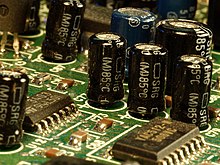What Are Some Examples of Hardware?
This is a lesson in the class Introduction to Computers, which is a part of The School of Informatics
Hardware [edit | edit source]

Inside a personal computer:
one. Monitor
2. Motherboard
3. CPU(Microprocessor
iv. Main memory(RAM)
5. Expansion cards.
6. Ability supply unit of measurement.
vii. Optical disc bulldoze.
8. Hard disk drive (HDD).
9. Keyboard.
ten. Mouse.
Hardware refers to the concrete elements of a estimator. Also referred to equally the machinery or the equipment of the computer. Examples of hardware in a computer are the keyboard, the monitor, the mouse and the processing unit Withal, most of a computer's hardware cannot be seen; It's inside the calculator case.
I/O lets the computer talk with the earth around it. Sometimes its necessary to add functionality to a computer to keep it upwardly to date, or make it better. The amount of I/O a computer has can exist changed, by adding expansion cards that support I/O. A graphics carte can exist added to a reckoner to permit it talk with a display, or a WiFi carte can be added, which volition let a computer talk to other computers without a connecting wire. Sometimes functionality can exist added through a universal port, a port that supports multiple kinds of I/O. USB, FireWire, and Thunderbolt (Types of I/O) support multiple data types. Your keyboard, mouse, and monitor all connect to a computer's I/O.
CPUs or processors perform computations. They do the math for your calculator awarding, they compare the size of numbers; people have likened the CPU to the "encephalon" of a estimator.
Memory is what allows a computer to recall things. Similar to human retentiveness, there's long term retentiveness (a hard disc or optical media (like a CD)) and brusque term memory (RAM). When a computer is turned off, it forgets everything in the RAM, so the figurer saves everything it knows it volition need later on in the long term retentiveness. The short term retentiveness is easier to use because it can practise I/O faster, so when a data is needed by the CPU, it's sent from the hard disk drive drive (HDD) to the RAM. The short term retentiveness lives on RAM, while the long term memory is in the hd (HDD). Optical disks permit you change certain parts of the memory, it's kind of similar having a book or notebook that you might read and get data from.
The motherboard is a piece of hardware that makes connections in the right places between all of the other components in a computer. It tells information where information technology should go. When the CPU is finished processing some data, it might say to the CPU, OK, put this in the HDD, and the motherboard volition effigy out where the HDD is and transport the information in that location.
Introduction to Motherboard [edit | edit source]
A motherboard is an electronic excursion board in a reckoner which interconnects hardware devices attached to information technology. At a minimum it includes i or more Cardinal processing units, and the main processing activeness of the computer takes place on it. However, other connected printed circuit boards may contain their ain pre-processing or post-processing CPUs, to take some of the load off of the motherboard; these, together with other plug-in boards without CPUs, may be called "daughter boards." Information technology was called a "female parent" board in relation to these. A PC motherboard may have a series of sockets, assuasive daughter boards to be plugged in directly. Other connectors on the motherboard let communication through cables with various peripheral devices, both inside and outside the computer case.
Ports [edit | edit source]
Ports are used past a motherboard to interface with electronics both inside and outside of the computer.
Serial [edit | edit source]

An example of a serial port
A legacy technology, serial ports were most often used to connect a mouse or modem. By circa 2000, nearly personal computers stopped relying on serial ports and were replaced by PS/two and/or USB ports. Series ports are sometimes however used for specialized applications such as industrial automation systems, scientific instruments, and betoken of sale systems.
PS/2 [edit | edit source]
PS/ii ports (now outdated) were for connecting peripherals such every bit your keyboard and mouse to the computer. PS/ii based mice and keyboards have now been replaced by USB ports equally the popular standard. This tendency for USB over PS/2 started in circa 2004.
Parallel [edit | edit source]
Parallel ports are used to connect other peripherals such every bit joysticks, and more than commonly, printers. Like to the serial port, this technology is slowly being phased out in favour of USB. Parallel ports can still exist plant in many motherboards today.
Small Computer Organization Interface (SCSI) [edit | edit source]
Pronounced "scuzzy", this was used primarily every bit a connectedness interface for tape drives and hard disk drives. SCSI has been superseded in favour of newer and cheaper technologies such as USB and Firewire.
USB [edit | edit source]
USB, short for Universal Serial Bus, is an manufacture standard developed in the mid-1990s that defines the cables, connectors and communications protocols used in a bus for connection, communication, and power supply between computers and electronic devices.[1] A omnibus is a communication system that transfers data between components inside a calculator, or between computers.[2]
Firewire [edit | edit source]
Technically known as the IEEE 1394 interface, but dubbed by Apple equally Firewire, this connection medium hoped to surpass USB in terms of speed and popularity. While it did outperform USB v2 in speed tests, uptake was very limited due to the existing widespread use of USB.
Slots [edit | edit source]
Slots are an opening in a computer where a circuit lath tin can be inserted to add new capabilities. All personal computers contain expansion slots for adding more than memory, graphics capabilities, and support for special devices. Expansion slots come up in different flavours, which volition be described below. An alternative explanation for expansion slots can be establish hither.
Graphics carte du jour [edit | edit source]

Graphic cards are also called video cards or a video adapter. They are in all PCs. Graphic cards convert signals into video signals and then the images can exist displayed on the monitor. While many graphics cards are integrated into the CPU these days, enthusiasts will invest in standalone graphics cards with stronger and more powerful processing capabilities. This allows for heavy image editing, or better rendering and framerates in figurer games.
Graphics cards are designed to offload rendering from the CPU. Graphics cards are powered by the motherboard and require a PCIX or PCIX 2.0 slot to install. Some cards require more ability and thus will demand a 6-8 pin connector that runs directly to the ability supply. Graphics cards also include on board memory for efficient rendering. Typical sizes include 128-1024mb of memory. Today, loftier stop graphics cards have multiple core processors that are largely parallel to increment texture fill and process more 3D objects in real time.
Graphics Carte du jour on Wikipedia
Audio card [edit | edit source]

A sound card, also referred to as an audio carte facilitates the input and output of audio signals to and from a computer under the command of reckoner programs. Sound cards for computers were uncommon until 1988, which left the single internal PC speaker as the but style early on PC software could produce sound and music.
Sound Card on Wikipedia.
Network Interface Cards (NICs) [edit | edit source]

Network Interface Cards can be a network card, network adapter, LAN Adapter or NIC (network interface card). They are a slice of computer hardware designed to allow computers to communicate over a computer network. It is used for fault communication via cable. Information is transmitted over a cable network. The NIC connects computers and other devices such as printers. Many modern motherboards have NICs built in by default.
NICs on Wikipedia
PC Card [edit | edit source]
A PC Card (originally PCMCIA Card) is a device that uses a specific peripheral interface designed for laptop computers.
PC Carte on Wikipedia
See Too [edit | edit source]
- Computer Hardware
- Information technology Fundamentals
References [edit | edit source]
- ↑ Wikipedia: USB
- ↑ Wikipedia: Bus (computing)
0 Response to "What Are Some Examples of Hardware?"
Post a Comment